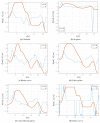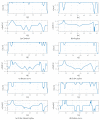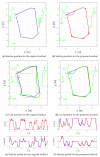Smooth Autonomous Patrolling for a Differential-Drive Mobile Robot in Dynamic Environments
- PMID: 37687877
- PMCID: PMC10490634
- DOI: 10.3390/s23177421
Smooth Autonomous Patrolling for a Differential-Drive Mobile Robot in Dynamic Environments
Abstract
Today, mobile robots have a wide range of real-world applications where they can replace or assist humans in many tasks, such as search and rescue, surveillance, patrolling, inspection, environmental monitoring, etc. These tasks usually require a robot to navigate through a dynamic environment with smooth, efficient, and safe motion. In this paper, we propose an online smooth-motion-planning method that generates a smooth, collision-free patrolling trajectory based on clothoid curves. Moreover, the proposed method combines global and local planning methods, which are suitable for changing large environments and enabling efficient path replanning with an arbitrary robot orientation. We propose a method for planning a smoothed path based on the golden ratio wherein a robot's orientation is aligned with a new path that avoids unknown obstacles. The simulation results show that the proposed algorithm reduces the patrolling execution time, path length, and deviation of the tracked trajectory from the patrolling route compared to the original patrolling method without smoothing. Furthermore, the proposed algorithm is suitable for real-time operation due to its computational simplicity, and its performance was validated through the results of an experiment employing a differential-drive mobile robot.
Keywords: mobile robot; motion planning; path smoothing; patrolling.
Conflict of interest statement
The authors declare no conflict of interest.
Figures




















References
-
- Farooq M.U., Eizad A., Bae H.K. Power solutions for autonomous mobile robots: A survey. Robot. Auton. Syst. 2023;159:104285. doi: 10.1016/j.robot.2022.104285. - DOI
-
- Azpúrua H., Saboia M., Freitas G.M., Clark L., Agha-mohammadi A.A., Pessin G., Campos M.F., Macharet D.G. A Survey on the autonomous exploration of confined subterranean spaces: Perspectives from real-word and industrial robotic deployments. Robot. Auton. Syst. 2023;160:104304. doi: 10.1016/j.robot.2022.104304. - DOI
-
- Couillard M., Fawcett J., Davison M. Optimizing Constrained Search Patterns for Remote Mine-Hunting Vehicles. IEEE J. Ocean. Eng. 2012;37:75–84. doi: 10.1109/JOE.2011.2173833. - DOI
-
- Abouaf J. Trial by fire: Teleoperated robot targets Chernobyl. IEEE Comput. Graph. Appl. 1998;18:10–14. doi: 10.1109/38.689654. - DOI
-
- Hoshino S., Ishiwata T., Ueda R. Optimal patrolling methodology of mobile robot for unknown visitors. Adv. Robot. 2016;30:1072–1085. doi: 10.1080/01691864.2016.1192064. - DOI
Grants and funding
LinkOut - more resources
Full Text Sources

